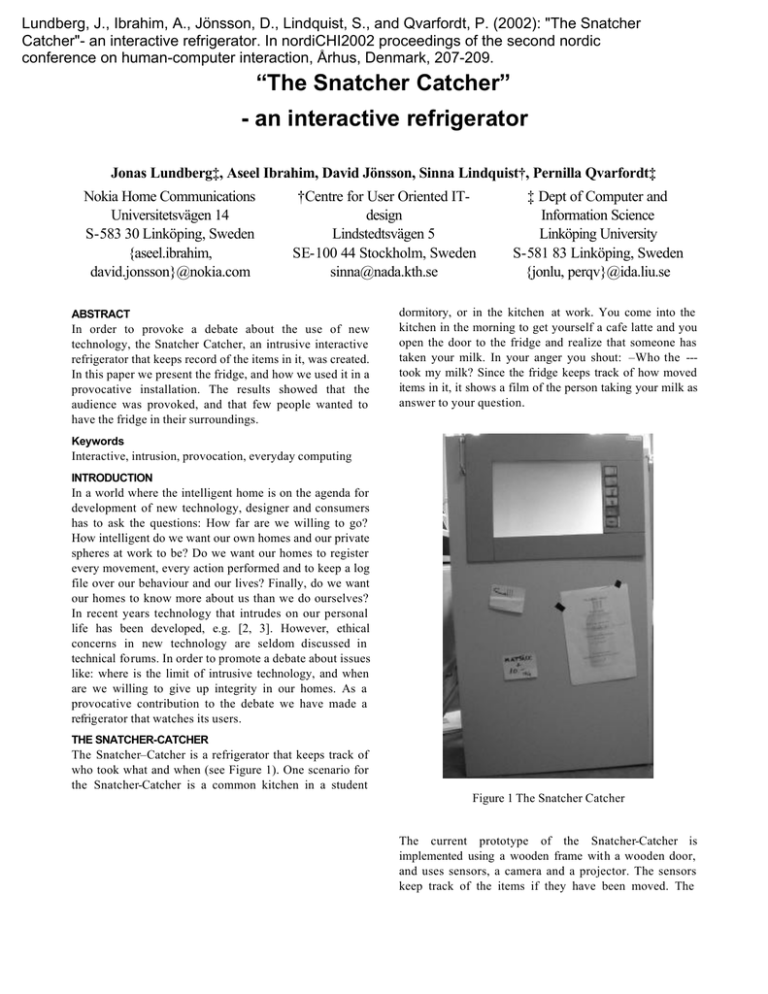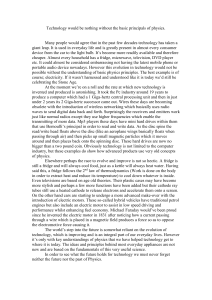Lundberg, J., Ibrahim, A., Jönsson, D., Lindquist, S., and Qvarfordt,... Catcher"- an interactive refrigerator. In nordiCHI2002 proceedings of the second...
advertisement

Lundberg, J., Ibrahim, A., Jönsson, D., Lindquist, S., and Qvarfordt, P. (2002): "The Snatcher
Catcher"- an interactive refrigerator. In nordiCHI2002 proceedings of the second nordic
conference on human-computer interaction, Århus, Denmark, 207-209.
“The Snatcher Catcher”
- an interactive refrigerator
Jonas Lundberg‡, Aseel Ibrahim, David Jönsson, Sinna Lindquist†, Pernilla Qvarfordt‡
Nokia Home Communications
Universitetsvägen 14
S-583 30 Linköping, Sweden
{aseel.ibrahim,
david.jonsson}@nokia.com
†Centre for User Oriented ITdesign
Lindstedtsvägen 5
SE-100 44 Stockholm, Sweden
sinna@nada.kth.se
ABSTRACT
In order to provoke a debate about the use of new
technology, the Snatcher Catcher, an intrusive interactive
refrigerator that keeps record of the items in it, was created.
In this paper we present the fridge, and how we used it in a
provocative installation. The results showed that the
audience was provoked, and that few people wanted to
have the fridge in their surroundings.
‡ Dept of Computer and
Information Science
Linköping University
S-581 83 Linköping, Sweden
{jonlu, perqv}@ida.liu.se
dormitory, or in the kitchen at work. You come into the
kitchen in the morning to get yourself a cafe latte and you
open the door to the fridge and realize that someone has
taken your milk. In your anger you shout: –Who the --took my milk? Since the fridge keeps track of how moved
items in it, it shows a film of the person taking your milk as
answer to your question.
Keywords
Interactive, intrusion, provocation, everyday computing
INTRODUCTION
In a world where the intelligent home is on the agenda for
development of new technology, designer and consumers
has to ask the questions: How far are we willing to go?
How intelligent do we want our own homes and our private
spheres at work to be? Do we want our homes to register
every movement, every action performed and to keep a log
file over our behaviour and our lives? Finally, do we want
our homes to know more about us than we do ourselves?
In recent years technology that intrudes on our personal
life has been developed, e.g. [2, 3]. However, ethical
concerns in new technology are seldom discussed in
technical forums. In order to promote a debate about issues
like: where is the limit of intrusive technology, and when
are we willing to give up integrity in our homes. As a
provocative contribution to the debate we have made a
refrigerator that watches its users.
THE SNATCHER-CATCHER
The Snatcher–Catcher is a refrigerator that keeps track of
who took what and when (see Figure 1). One scenario for
the Snatcher-Catcher is a common kitchen in a student
Figure 1 The Snatcher Catcher
The current prototype of the Snatcher-Catcher is
implemented using a wooden frame with a wooden door,
and uses sensors, a camera and a projector. The sensors
keep track of the items if they have been moved. The
camera starts filming when the door is opened. If something
has been moved during the time the door is opened, this is
connected to buttons on the door. When the door is closed
and a user press a button connected to an item in the
fridge, the film is shown on a back projection screen on the
door, which is only active when the door is closed.
PROVOCATION AS A METHOD
Provoke means exc ite, stimulate, pique or irritate.
Provocation has been used in art since the beginning of the
20th century in the radical avant-garde movements. But
design researchers also use provocation as part of their
method. Gaver [1] invented the Cultural Probe, which is a
package with different material “designed to provoke
inspirational responses” from the users. Like a Cultural
Probe, the Snatcher–Catcher installation is one way to
trigger feelings about privacy and integrity, and also irritate
and stimulate people to give us immediate feedback during
the presentation.
“Most people feel an attachment to the place where they
live and work; consequently they develop a protective
attitude towards ‘their’ territory” [4]. When art, and
especially provocative art, is placed in public places people
tend to feel that they are imposed of something they had
not asked for. It is often the same thing with technology.
Technology that takes a great place, either in the physical
space or in the mental space, is often found provocative.
This is obvious during an initial phase of using
technology, until we have got used to it. The mobile phone
for example, was intrusive when it first was used in public
spaces. Nowadays the discussions whether it is good or
bad with people talking private matters loud in public are
not as frequent as before.
The refrigerator is a natural thing in a work place kitchen. A
surveillance camera in a fridge is not suspected. Even
though the camera is there for ‘your sake’, to see who stole
your milk, you might get upset to notice yourself being
filmed every time you open the fridge door.
Our attempt is not artistic but to provoke people to respond
to the idea with the Snatcher-Catcher. The provocative
prototype is not one stage in a technology development of
an intelligent refrigerator. It is more like a set of questions
on what privacy is worth. By showing the Snatcher-Catcher
we might find some answers to that through the audiences’
comments and acting.
PRESENTATION OF THE PROTOTYPE
The prototype fridge has been shown twice, first at the
Museum of Science and Technology in Stockholm as part
of an exhibition on the disappearing computer theme, and
the second time at a conference on Human-Computer
Interaction as a demonstration. The purpose of showing
the fridge prototype was to investigate the reactions of the
audience. The audience was invited to approach the fridge
by posters and by a presenter. The poster shortly
introduced the context of the Snatcher-Catcher. The
presenter acted as salesman of the Snatcher-Catcher as a
part of the installation. The presentation was enthusiastic
and the “salesman” talked about the possibilities of the
technology used in the fridge. The presenter gave a brief
introduction of the context of the fridge, and the problem
the fridge was supposed to solve. Then the functionality of
the fridge was demonstrated and the audience was invited
to act as thieves and owners of items in the fridge.
Both demonstrations were video filmed, and the second
time there was also a questionnaire handed out to the
audience. We had deliberately made few and comparatively
open questions so that answering the questionnaire would
not take much effort. However, many of the visitors
answered the questions more thoroughly, than we had
expected, to be exact 31 out of approximately 75
responding.
REACTIONS
The four questions were: Your spontaneous reaction,
Describe the Snatcher-Catcher with three words, Where
would you like to place a fridge like this, and Can you see
other usability for this kind of technical solution.
Most of the users had a positive attitude to the fridge.
People were laughing when they were told the scenario and
understood the use of it. They gave comments like ‘this
would really be something to put in our kitchen at work’.
The reactions were predominately in the direction that the
fridge would fill a need, and that it was a cool extra gadget.
They could see many areas of use for it, but they would not
like it in their own surrounding. It would be more suitable to
place it ‘in the girlfriends kitchen’ or at someone else’s
workplace. Some people also answered by asking
questions. –‘Nice, but what do I do it the thief is bigger
than I am?’ and ‘–Nice, but is it possible to build a ‘who
didn’t wash the coffee mug’ too?’ and ‘–Will I get my milk
back if I know who stole it?’ There is of course no good
answer to these questions, but they show the difficulty
with trying to solve a social problem with technology only.
Interesting is that the positive comments are focused on
some kind of justice (and perhaps revenge).
There were, however, some that where more doubtful. On
the con side, the main objective was that the fridge was
close in function to the dictatorship described in the novel
1984 by George Orwell. The feeling of having a Big Brother
watching you everywhere was too close. The fridge was
intruding the personal privacy. In the negative comments,
focus lies within the personal integrity.
DISCUSSION
The main result we have seen from doing this provocation
is that people do not seem to get that upset of being
registered, as long as it not is in their close environment.
The fridge was generally well met by the audience. Maybe
the setting made the intrusion less. The audience is
prepared to be a bit provoked in a setting like that. They
want to encourage and they want to be a bit surprised, and
as persons working with technology, they have a general
positive attitude towards technology.
ACKNOWLEDGMENTS
One reason for the positive comments in the questionnaire
could be that the desire of revenge and justice is higher,
than the sacrifices you do with intruding the personal
integrity. The reason behind this could be that the fridge is
to far for being a threat to them. The reactions of not
having a problem placing the fridge anywhere, except at
their own home emphasise this. The question that raises
then is how close is close enough?
REFERENCES
In this study the audience were provoked, either giving
positive or negative responses. An interesting question:
how could we have made the fridge more intruding in order
to get stronger responses from the audience? An idea is to
make the installation in a real setting at a work place.
Another idea is to make the fridge reacting on speech, so
that the spontaneous reaction of the users is used for
interaction.
We would like to give our thanks to the Museum of
Science and Technology in Stockholm and the people who
participated in the demonstrations.
1. Gaver, B., Dunne, T., Pacenti, E. 1999. Cultural Probes.
interactions, 6 (1), Jan. 1999, pp.21-29.
2. Hindus, D., Mainwaring, S., Leduc, N., Hagstrom, A.
and O. Bayley. “Casablanca: Designing Social Commu nication Devices for the Home.” Proceedings of CHI
’01. (2001), ACM Press, 325-332.
3. Mynatt, E., Rowan, J., Jacobs, A. and S. Craighill. “Digital Family Portraits: Supporting Peace of Mind for
Extended Family Members.” Proceedings of CHI ’01.
(2001), ACM Press, 333-340.
4. Walker, John A. 1999. Art and Outrage: Provocation,
Controversy and the Visual Arts. Pluto Press: London.






